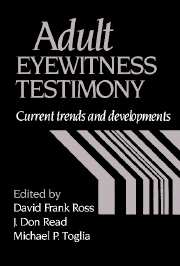Book contents
- Frontmatter
- Contents
- List of contributors
- Preface
- Part I Cognitive, physical and social processes and factors influencing eyewitness recall and identification
- Part II Lineup construction and collection of testimony
- 8 Conceptual, practical, and empirical issues associated with eyewitness identification test media
- 9 Biased lineups: Where do they come from?
- 10 Evaluating the fairness of lineups
- 11 Recommendations for properly conducted lineup identification tasks
- 12 Improving eyewitness testimony with the Cognitive Interview
- Part III Whom to believe? Distinguishing accurate from inaccurate eyewitnesses
- Name index
- Subject index
9 - Biased lineups: Where do they come from?
Published online by Cambridge University Press: 04 August 2010
- Frontmatter
- Contents
- List of contributors
- Preface
- Part I Cognitive, physical and social processes and factors influencing eyewitness recall and identification
- Part II Lineup construction and collection of testimony
- 8 Conceptual, practical, and empirical issues associated with eyewitness identification test media
- 9 Biased lineups: Where do they come from?
- 10 Evaluating the fairness of lineups
- 11 Recommendations for properly conducted lineup identification tasks
- 12 Improving eyewitness testimony with the Cognitive Interview
- Part III Whom to believe? Distinguishing accurate from inaccurate eyewitnesses
- Name index
- Subject index
Summary
Over the past two decades eyewitness researchers have employed staged crimes to investigate the impact of biased lineup procedures on eyewitness identification accuracy. The results have been remarkably consistent. Biased lineups dramatically increase the rate of false identifications of innocent people but have little effect on the rate of correct identification. This pattern has been found for lineups biased because the foils did not resemble the suspects (Lindsay & Wells, 1980), only the suspects wore clothing similar to that worn during the crime (Lindsay, Lea, Nosworthy, Fulford, Hector, LeVan, & Seabrook, 1991; Lindsay, Wallbridge, & Drennan, 1987), or the instructions led witnesses to believe that the guilty person must be in the lineup (Kohnken & Maass, 1988; Lindsay et al., 1991; Malpass & Devine, 1981).
These studies of lineup bias were stimulated by real world examples of highly biased lineups. One of the most notorious is the black suspect in an otherwise all white lineup used by police in Minneapolis (Ellison & Buckhout, 1981). In that case, police explained the use of only white foils by claiming there were no other blacks in the building when the lineup was constructed and that there were few blacks in Minneapolis so the lineup was representative of the population. Neither of these explanations is acceptable. Surely other blacks could have been found with little delay and juries, not lineups, should be representative of the population. This example and others remain inadequately explained.
For the remainder of this discussion, poor lineup foils will be used as the source of lineup bias although there is no reason for the points made to be different if another form of lineup bias were to be considered.
- Type
- Chapter
- Information
- Adult Eyewitness TestimonyCurrent Trends and Developments, pp. 182 - 200Publisher: Cambridge University PressPrint publication year: 1994
- 4
- Cited by

